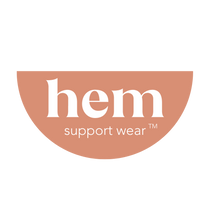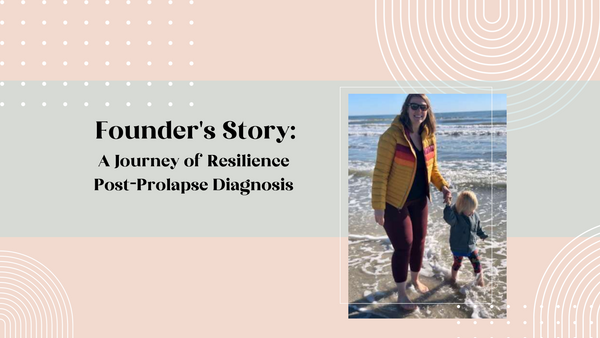Founder's Story: A Journey of Resilience Post-Prolapse Diagnosis
Recently, our founder Lauren shared her story with the community at Pelvic Health Support (PHS), a ground-breaking digital resource dedicated to to raising awareness, educating and providing support for those living with pelvic health conditions. Their goal is to act as a guide to help you achieve optimal pelvic health through a biophysical approach.
Check out her story here or continue reading below!
I learned about pelvic organ prolapse (POP) for the first time after having my first baby. She was born in May 2020, shortly after the COVID-19 pandemic started, and a few weeks later I started having a feeling in my vagina that I had not felt before. (I did not know how to explain it at the time, but I later learned to use terms like “heaviness” and “pressure” to describe what I was feeling.)
After a few weeks postpartum, I used a handheld mirror to look and see what was going on. I saw what I would later learn was vaginal tissue bulging out of my vagina. It looked like my insides were falling out. It was alarming to say the least. I felt concerned and unsure of what was going on. Like with so many things that I do not know the answer to, I turned to Google to try to see if I could figure out what was happening. I know searching the internet can be a slippery slope, especially for health concerns, but I needed information on what might be causing my symptoms. Based on my research, I was pretty sure that I had pelvic organ prolapse.
I took a few pictures so I could show my healthcare provider at my six week postpartum visit. I showed her the pictures and told her I thought I had a prolapse. She examined me in a few different positions and ultimately said that I did not have a prolapse. This was disheartening because I felt dismissed by my provider.
Thankfully, I had learned about pelvic floor physical therapy (PFPT) from my doula community and already had purchased a postpartum care package with my pelvic floor physical therapist. She confirmed that I had prolapse and helped answer my questions, which calmed my nerves. She reassured me that everything was, in fact, not going to fall out and reminded me that I was still very early postpartum. This was reassuring because I finally felt seen and heard.
My pelvic floor PT was a wealth of information and made me a personalized recovery plan. At every visit, she answered my questions, assessed my progress, and adjusted my plan as needed. She recommended I purchase a pelvic floor support garment to help mitigate my symptoms while I worked on giving my body time to recover and progress through my strength program.
I tried many different garments and wore them at various times to help find relief. I really struggled with the garments I tried because they all made me feel like I had a problem, were uncomfortable, and did not make me feel like myself. I was never able to find a garment that I liked enough to consistently wear, even though they provided relief that I desperately needed. In late 2020, I had my lightbulb moment that there was a real need for better pelvic floor support garments. Since I couldn’t find one, I decided I would be the one to create it. I began my journey to start Hem Support Wear and reimagine the pelvic floor support garment.
After years of development, 20+ prototypes and hundreds of hours of testing, we launched our first line of high waisted pelvic floor support underwear and have been thrilled with the feedback we’ve received. Our garments provide the needed support with a patent-pending support hammock and are designed to be beautiful and comfortable so people will actually want to wear them. We strongly believe that people deserve to feel supported and feel like themselves as much as possible on their pelvic health journeys.
My recovery was a slow process after having both of my babies. After my first, I had varying levels of POP symptoms until about 15 months postpartum. Around that time I finally felt like my POP symptoms were mostly going away. It is hard to say why my symptoms mostly went away at that time, but some contributing factors are that I was in a good groove on consistent strength training, my daughter had weaned from breastfeeding at about 13 months and I was 15 months postpartum (i.e. I gave my body time).
As I write this, I am about 13 months postpartum after my second baby. I have some level of POP symptoms daily, but there are many days when I do not think about it at all. One of the things I learned during all of this is how unrealistic many expectations are regarding how quickly your body recovers after giving birth. Postpartum should be talked about in terms of months, not weeks.
Working with a pelvic floor physical therapist was an important part of my journey and I am so thankful I had one early in the process. She gave me hope and the tools to take control of my recovery and feel confident moving forward. That is not to say it was an easy journey. There were so many days when I felt beat down and discouraged. I felt like I had a problem and like my body had failed me.
Anyone who has been diagnosed with a pelvic floor disorder knows how taxing it can be physically, mentally and emotionally, and I still have days when I feel overwhelmed and beat down by my symptoms. I find the silver lining is that if I had not gotten prolapse I would have never known there was such a need for better pelvic floor support garments and would not be on the path I am today.
In the last three years I have taken on new identities. I became a mom to two incredible girls. I became a person with prolapse. And I became an entrepreneur. I am hopeful that my experience will mean that I can provide a better future for my girls when it comes to pelvic health and make a small impact for the millions of women who suffer with pelvic floor disorders. I am optimistic that we can make meaningful change even if just one small step at a time. Here’s to a world where our pelvic health is talked about and given the attention it deserves.



